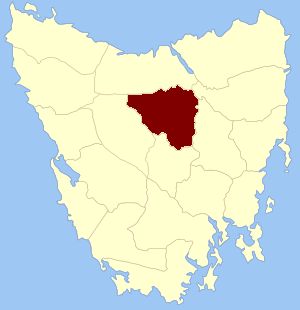Westmoreland Land District facts for kids
Quick facts for kids WestmorelandTasmania |
|||||||||||||||
|---|---|---|---|---|---|---|---|---|---|---|---|---|---|---|---|

Location in Tasmania
|
|||||||||||||||
|
|||||||||||||||
The Westmoreland Land District is one of the twenty special areas in Tasmania used for keeping track of land. These areas are part of the Cadastral divisions of Tasmania, which are like a map system for land ownership and boundaries. Long ago, Westmoreland was also known as one of the 18 counties of Tasmania.
Contents
How Land Was Organized in Early Tasmania
Back on January 15, 1836, George Arthur, who was the Lieutenant Governor of Van Diemen's Land (that's what Tasmania was called then), made an important announcement. He used a newspaper called The Hobart Town Courier to tell everyone about the first counties and parishes. These were the first official ways to divide up the land in the colony.
Defining Westmoreland's Borders
When Westmoreland was first created, its borders were carefully described. They used natural features like rivers and lakes to mark where the district began and ended. For example, the Meander River was part of its northern border. Other rivers like the South Esk River and Lake River helped define its eastern side.
The southern border stretched from Wood's Lake to the Shannon River. The western side followed the River Nive and then a line towards the Mersey River. These detailed descriptions helped people know exactly where their land was located.
Early Land Divisions: Hundreds and Parishes
When the land was first divided, it was split into larger areas called "hundreds" and smaller areas called "parishes." These names might sound old-fashioned, but they were important for organizing the new colony.
Two main "hundreds" were created within Westmoreland:
- The hundred of Norfolk Plains
- This area included several parishes:
- Longford parish
- Cressy parish
- Carrick parish
- Little Hampton parish
- This area included several parishes:
- The hundred of Westbury
- This area also had its own parishes:
- Westbury parish
- Quamby parish
- Sillwood parish
- Adelphi parish
- This area also had its own parishes:
Important Towns in Westmoreland
Several towns were officially recognized as being within the Westmoreland county. These included:
These towns grew as people settled in the area and started new lives.

